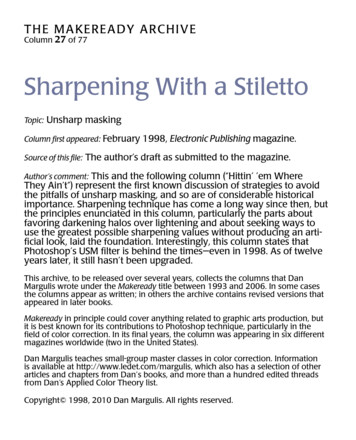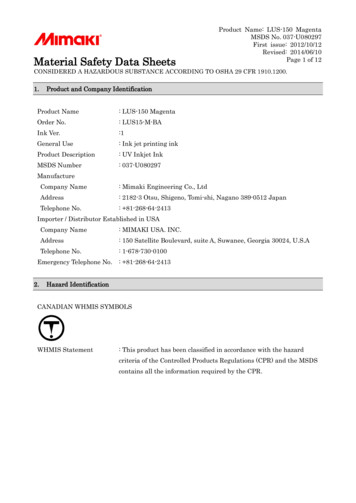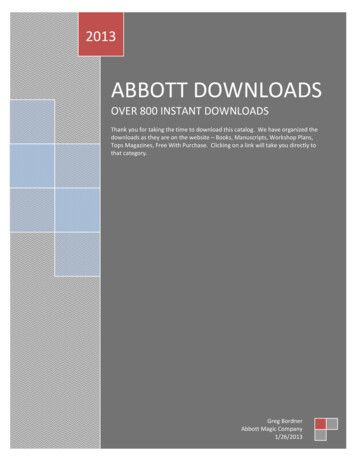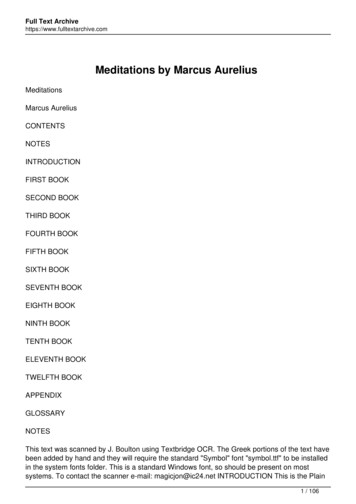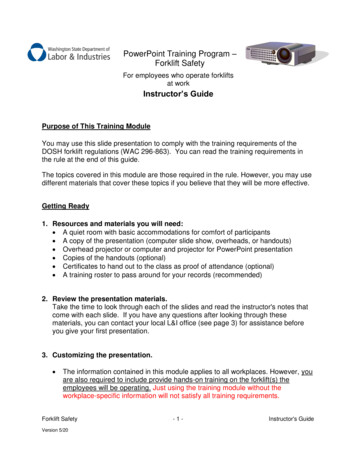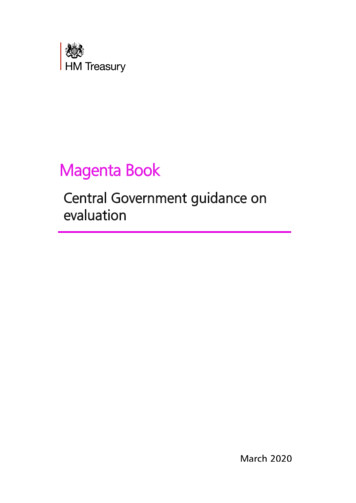
Transcription
Magenta BookCentral Government guidance onevaluationMarch 2020
Magenta BookCentral Government guidance onevaluationMarch 2020
Crown copyright 2020This publication is licensed under the terms of the Open Government Licence v3.0 exceptwhere otherwise stated. To view this licence, visit /version/3 or write to the Information Policy Team, The NationalArchives, Kew, London TW9 4DU, or email: psi@nationalarchives.gov.uk.Where we have identified any third party copyright information you will need to obtainpermission from the copyright holders concerned.This publication is available at www.gov.uk/official-documents.Any enquiries regarding this publication should be sent to us atpublic.enquiries@hmtreasury.gov.ukISBN 978-1-913635-18-3 PU2957
ContentsExecutive Summary . 5What is evaluation? . 5When is evaluation useful? . 5What are its purposes? . 5What does evaluation mean in practice? . 6Structure of the Magenta Book . 6Key terminology . 7CHAPTER 1 Why, how and when to evaluate? . 81.1. Introduction . 81.2. What is policy evaluation?. 91.3. Why evaluate? . 91.4. What role does evaluation have? . 101.5. When to evaluate?. 121.6. Why start planning early? . 131.7. Aligning evaluation with business planning . 141.8. Types of evaluation . 141.9. What is a ‘good’ evaluation? . 151.10. Who are the stakeholders of evaluation? . 171.11. Who conducts evaluation? . 171.12. The stages of an evaluation . 18CHAPTER 2 Evaluation scoping . 212.1. Introduction . 212.2. Evaluation scoping. 242.3. Designing an evaluation . 38Chapter 3 Evaluation methods. 403.1. Introduction . 403.2. Choosing the appropriate methods . 413.3. Research methods used in both process and impact evaluations . 413.4. Theory-based impact evaluation methods . 433.5. Experimental and quasi-experimental impact evaluation methods. 463.6. Value-for-Money evaluation methods . 493.7. Synthesis methods . 50Chapter 4 Data collection, data access and data linking . 534.1. Introduction . 534.2. Deciding what data is required . 544.3. Sources of data. 554.4. Data quality . 634.5. Data handling. 644.6. Data linking . 65Chapter 5 Managing an evaluation . 681
5.1. Introduction . 685.2. Establishing the evaluation . 685.3. Governance . 705.4. Linking evaluation to the intervention design . 715.5. Specifying an evaluation . 725.6. Commissioning an evaluation. 745.7. Flexibility and consistency. 745.8. Quality assurance. 755.9. Ethics . 75Chapter 6 The use and dissemination of evaluation findings . 806.1. Introduction . 806.2. Developing an evaluation use and dissemination plan . 816.3. Disseminating evaluation findings . 826.4. Building an evaluation culture . 836.5. Publication . 836.6. Openness and transparency . 84Chapter 7 Evaluation capabilities . 857.1. Introduction . 857.2. Scoping . 857.3. Leading and managing . 867.4. Methods . 877.5. Use and dissemination . 887.6. Further detail . 892
ForewordUnderstanding the efficiency and effectiveness of interventions and their impacts is critical toeffective decision-making. In 2019, HM Treasury published an updated Public ValuesFramework, in response to the Barber review 1, which reinforces the importance of maximisingthe value delivered from public spending and improving outcomes for citizens. Robustevaluation has a crucial role to play in meeting these goals.This updated version of the Magenta Book provides a comprehensive overview of evaluation ingovernment: its scoping, design, management, use and dissemination, as well as thecapabilities required of government evaluators. It provides new material on the evolvingapproaches and methods used in evaluation; and emphasises the value of evaluation inproviding evidence for the design, implementation and review stages of the policy cycle.The Book is written for the policy, delivery and analysis professions; all of which are responsiblefor securing and using good evidence. Evaluation should be built into an intervention’s designand delivery from the earliest stages; small changes in intervention design can make a largedifference to evidence that can be generated.As before, the Magenta Book has been aligned with the revised HM Treasury Green Book 2,which sets out the economic principles that should be applied to both appraisal and evaluation.High quality evaluation evidence can enable decision-makers to better target their intervention;reduce delivery risk; maximise the chance of achieving the desired objectives; and increase ourunderstanding of what works. Without robust, defensible evaluation evidence, governmentcannot know whether interventions are effective or even if they deliver any value at all.Routine, high-quality evaluation is part of a culture of continual improvement and should becore to the work of all government departments. It will also provide the source of informationfor others to learn from (across public services and communities).Signed:Ian DiamondJonathan SlaterHead of Analysis Function BoardHead of the Policy Profession12HM Treasury, 2019. The Public Value Framework: with supplementary guidance. Available ic-value-framework-and-supplementary-guidanceHM Treasury, 2018. The Green Book: Central Government Guidance on Appraisal and Evaluation. London. CrownCopyright. Available ment/uploads/system/uploads/attachment data/file/685903/The Green Book.pdf3
AcknowledgementsHM Treasury would like to thank the Cross-Government Evaluation Group for steering therewrite of the Magenta Book. In particular, thanks go to the chapter authors and editors:Siobhan CampbellTim ChadbornAmy ColemanMike DalySteven FinchCatherine FlynnAlison HigginsMarianne LawTarran MacmillanEdmund O'MahonyAnna Rios WilksHM Treasury also gratefully acknowledges the contributions from analysts and policy makersacross government, in addition to the work of authors of previous versions of the MagentaBook.Finally, we thank all those involved in the consultation process and in providing feedback,including the Centre for the Evaluation of Complexity Across the Nexus (CECAN), whodeveloped the supplementary guidance on evaluating complexity, and the UK Evaluation Society(UKES), who provided peer review.4
Executive SummaryWhat is evaluation?Evaluation is a systematic assessment of the design, implementation and outcomes of anintervention3, 4. It involves understanding how an intervention is being, or has been,implemented and what effects it has, for whom and why. It identifies what can be improvedand estimates its overall impacts and cost-effectiveness.When is evaluation useful?Evaluation can inform thinking before, during and after an intervention’s implementation.Different questions are answered at each stage: BEFORE – What can we learn from previous evaluations of similarinterventions? 5 How is the intervention expected to work? How is it expected to bedelivered? Are its assumptions valid? Can it be piloted and tested before full rollout? Can the roll-out be designed to maximise potential learning?Provides evidence that informs the intervention design, how best to implementthe design and what the likely outcomes might be. Helps identify and reduceuncertainty. DURING – Is the intervention working as intended? Is it being delivered asintended? What are the emerging impacts? Why? How can it be improved? Arethere unintended consequences?Provides evidence on the implementation of the intervention and any emergingoutcomes so that it can be continually improved. AFTER – Did the intervention work? By how much? At what cost? What have welearned about its design and its implementation? Are the changes sustained?Provides evidence on the design, implementation and outcomes, drawing outlessons for the future and providing an assessment of the overall impact of theintervention.What are its purposes?There are two main purposes for carrying out an evaluation: learning and accountability.3Where an “intervention” is any policy, programme or other government activity meant to elicit a change.Treasury. (2018). The Green Book: Central Government Guidance on Appraisal and Evaluation. [pdf]. London.Crown Copyright. Available ment/uploads/system/uploads/attachment data/file/685903/The GreenBook.pdf [Accessed 5th November 2019]5 The What Works Network uses evidence to improve the design and delivery of public services. It has multiplecentres focusing on different policy areas. Gov.UK, (2013). What Works Network Official Website. [online]Available at: -what-works-network [Accessed 5thNovember 2019]4 HM5
Learning To help manage risk and uncertainty (of the intervention and its implementation); To improve current interventions by providing the evidence to make better decisions(and feed into performance-management and benefits-realisation work); To gain a general understanding of what works, for whom and when, and generateexamples for future policy-making; To develop evidence to inform future interventions.AccountabilityGovernment departments should be accountable and transparent, to the Accounting Officerand other stakeholders. Evidence should be generated that can demonstrate an intervention’simpact or wider outcomes. Evidence of its effectiveness is also needed for Spending Reviewsand in response to scrutiny and challenge from public accountability bodies.What does evaluation mean in practice?Monitoring and evaluation are closely related, and a typical evaluation will rely heavily onmonitoring data. To be done well, both monitoring and evaluation should be done during thepolicy development stage with skilled expertise to ensure real-time evidence is available duringimplementation to aid decision-making. A comprehensive evaluation will typically consist of: Analysis of:o whether an intervention is being implemented as intended;o whether the design is working;o what is working more or less well and why.Together, these types of questions are typically referred to as a process evaluation. An objective test of what changes have occurred, the scale of those changes and anassessment of the extent to which they can be attributed to the intervention.This is typically referred to as an impact evaluation and is investigated through theorybased, experimental, and / or quasi-experimental approaches. A comparison of the benefits and costs of the intervention; typically referred to as avalue-for-money evaluation.In order to fully understand an intervention’s design, impact and results, all elements need to beexplored.Structure of the Magenta BookThis book looks at the types of evaluation (process, impact and value-for-money) and the mainevaluation approaches (theory-based and experimental), as well as setting out the main stagesof developing and executing an evaluation. The chapters are: Chapter 1: Why, how and when to evaluate? Chapter 2: Scoping and early design Chapter 3: Evaluation methods Chapter 4: Data collection, data access and data linkingChapter 5: Managing an evaluation6
Chapter 6: The use and dissemination of evaluation findings Chapter 7: Evaluation capabilities Annex A: Analytical methods for use within an evaluation designSupplementary guides provide further detail on particular topics: Quality in Qualitative Evaluation Realist Evaluation Handling Complexity in Policy Evaluation Government Analytical Evaluation Capabilities Framework Guidance for Conducting Regulatory Post Implementation ReviewsThis Book is to be used in conjunction with the Green Book 6, other Government Standards 7and Codes of Conduct.Key terminologyThe table below sets out some key concepts and their terminology used in this Book (note thatother, non-government guides may use slightly different wording).TermEvaluation designUse in the Magenta BookThe overarching design of the whole evaluation, which includes howthe evaluation will meet the learning aims specified during the scopingstage.“the whole thing all together”Chapters 2, 3, 4, 5 and 6 cover elements that all together form theoverarching evaluation design.Evaluation typesThe type of evaluation is defined by the evaluation questions (seeTable of evaluation questions). Common types of evaluation includeprocess, impact and value-for-money.Evaluation approachThe way that the answering of evaluation questions is approached; forexample, impact evaluations may use a theory-based approach and/oran experimental approach.Evaluation methodsThe way that information is collected and analysed in order to testtheories and answer the evaluation questions (e.g. difference indifference, modelling, randomised control trials)Data collectionThe collection of information to use in evaluation; this can bequantitative or qualitative.6 HMTreasury. (2018). The Green Book: Central Government Guidance on Appraisal and Evaluation. [pdf] London.Crown Copyright. Available ment/uploads/system/uploads/attachment data/file/685903/The Green Book.pdfGreen Book 2018. CENTRAL GOVERNMENT GUIDANCE ON APPRAISALAND EVALUATION [Accessed 5thNovember 2019]7 Government Analysis Function. (2019). Government Functional Standard GovS 010: Analysis. [pdf]. Crowncopyright. Available at: nctional-standard-govs-010-analysis-live/[Accessed 5th November 2019]7
InterventionAnything intended to elicit change, including a programme, policy,project, regulation and changes in delivery method.8
CHAPTER 1Why, how and when to evaluate?SummaryEvaluations of government interventions should be proportionate and fit-for-purpose.Evaluation plays a role in policy design, development and delivery, as well as in informing thedesign of subsequent interventions.Planning an evaluation early allows for an intervention to be designed in a way that canmaximise the learning that can be gained. It can also reduce the costs of data collection bybuilding this into the intervention’s delivery.There are three main types of evaluation: process, impact and value-for-money evaluations;each focused on answering different types of questions. For a full understanding of whether anintervention worked, how, why and for whom, and at what cost, all three types of evaluationare required.A good evaluation is useful, credible, robust, proportionate and tailored around the needs ofvarious stakeholders, such as decision-makers, users, implementers and the public. Byresponding to potential users’ needs, the outputs should be both usable and useful.Planning an evaluation requires consideration of both the design and the project managementof the evaluation. This typically requires expertise and resource.1.1. IntroductionIt is essential that public money is well spent, that government intervention is well-targeted, andthat any regulation is an appropriate balance between burden and protection. Thegovernment, public and all other stakeholders should be able to learn from and build on whathas gone before. They should also be able to scrutinise whether: the intervention was effective,the outcomes were achieved and the money was well spent. Evaluation is one way to achievethis accountability and learning. All policies, programmes and projects should be subject toproportionate evaluation.The Magenta Book has been written for government decision-makers and government analyststo help them understand the role of evaluation and the processes and methods for conductingan evaluation. It should also be of benefit to the wider research community, particularly thosebidding for government work, and to other commissioners, such as local authorities andcharities, who also develop and deliver policies and interventions.Government aims to conduct proportionate, fit-for-purpose evaluations that are genuinelyuseful to decision makers. In the immediate term they can provide evidence that can improvethe intervention being examined. In the longer-term, they can help build the evidence base,inform future policy development and delivery and assess value-for-money.The Magenta Book should be read alongside the Green Book: guidance on appraisal andevaluation in central government, which sets out why and how to conduct appraisal ofgovernment policy, and the rationale for the early planning of evaluation.
1.2. What is policy evaluation?Policy evaluation is the systematic assessment of a Government policy’s design, implementationand outcomes. It involves understanding how a government intervention is being or has beenimplemented and what effects it has had, for whom and why. It also comprises identifyingwhat can be improved and how, as well as; estimating overall impacts and cost-effectiveness.Evaluations differ in scale and ambition, but at their core they all seek evidence to answerquestions, such as: Is the intervention working as intended? Is it working differently for different groups? Why, or why not, might it be working differently for different groups? How is the policy operating in practice? Where can the policy be improved? What was the overall impact of the policy? Is it value-for-money? If we were to do it again, what would we do differently?1.3. Why evaluate?Two primary reasons to evaluate are learning and accountability.1.3.1. LearningIn terms of learning, evaluations can provide the evidence with which to manage risk anduncertainty. Especially in areas that are innovative or breaking new ground, there is a need forevidence to illustrate whether an intervention is working as intended. Early learning can alsoilluminate which parts are particularly successful or unsuccessful and what needs to be adaptedto improve performance. Pilots can be useful in this context as they allow the design,implementation and outcomes to be tested in a controlled environment at a smaller scale togenerate evidence to inform a broader policy initiative.Even areas with less uncertainty can often benefit from evaluation: to provide evidence toinform a benefits management strategy to help realise the anticipated benefits; or tounderstand how to maximise the efficiency and effectiveness of delivery. Even when we are veryconfident that an intervention will be effective, we would at the very least want to monitoroutcomes and confirm that they are in line with expectations.Evaluations also generate learning on what works for whom, when and why. Interventions arerarely conducted in isolation, and are typically one strand of a greater programme, building onwhat has gone before and soon replaced with another idea. It is important that we learn frominterventions, so that we can apply that learning to subsequent policies in the same area orother related areas. Even policies that are terminated because they are considered ineffectiveor too costly can produce valuable learning about mistakes to avoid in the future, or identifywhether any elements of the policy were successful.Fundamentally, learning is about good decision-making. Evaluation can provide evidence toinform decisions on whether to continue a policy, how to improve it, how to minimise risk, orwhether to stop and invest elsewhere.9
1.3.2. AccountabilityAnother main reason to evaluate is for accountability purposes. Government makes decisionson people's behalf and spends tax collected from individuals and businesses. Government alsouses regulatory initiatives, which run the risk of being overly-burdensome or having perverseoutcomes for some. Government has a responsibility to maximise public value and outcomesdelivered for taxpayers’ money and government activity. Evaluation has a crucial role to play inthis 8.Government departments must also inform the public about the outcomes and value of theinitiatives they put in place and be accountable and transparent to their Accounting Officer fortheir spending. Evidence of policy effectiveness is also required for Spending Reviews and inresponse to scrutiny and challenge from bodies, such as: National Audit Office 9 / Public Accounts Committee Select Committees Infrastructure and Projects Authority (IPA) Better Regulation Executive / Regulatory Policy Committee International Development Committee.In some cases, such as the following, evaluation is mandatory: Regulatory policies subject to Post-Implementation Review (PIR) 10, 11 Regulations containing a Sunset or a Duty to Review clause To meet the requirements of the International Development Assistance Act 2015.Evaluations for accountability tend to focus on monitoring and assessing impact.In practice, balancing learning and accountability can be difficult. There will be more or less of afocus on each depending on the role that evaluation will play with the specific interventionunder consideration and the needs of stakeholders.1.4. What role does evaluation have?Evaluation has a role at all stages in the policy lifecycle. The Green Book presents a frameworkfor the appraisal and evaluation of all policies, programmes and projects known as‘ROAMEF’. The ROAMEF framework is useful for thinking about the key stages in thedevelopment of a proposal, from the articulation of the rationale for intervention and the8 HM Treasury. (2019). The Public Value Framework. [pdf]. London. Crown Copyright. Available ment/uploads/system/uploads/attachment data/file/785553/public value framework and supplementary guidance web.pdf [Accessed 5th November 2019]9 nao.org.uk. (undated). Assessing Value for Money. [online] Available at: r-money/# [Accessed 5th November 2018]10 The Better Regulation Framework outlines the Post Implementation Review process. Department for Business,Energy and Industrial Strategy. (2018). Better Regulation Framework Guidance. [pdf]. Crown Copyright. uk/government/uploads/system/uploads/attachment m-guidance-2018.pdf [Accessed 5th November 2019]11 Statutory guidance on reviews includes guidance on when to include a review clause. Department for Business,Energy and Industrial Strategy. (2015). Small Business, Enterprise and Employment Act 2015. Statutory Guidanceunder s.31 of the Small Business, Enterprise and Employment Act. [pdf]. Crown Copyright. Available -reviewrequirements [Accessed 5th November 2019]10
setting of objectives, through to options appraisal and, eventually, implementation and finalevaluation, including the feeding back of evaluation evidence back into the policy cycle.Figure 1.1: The ROAMEF Cycle11
In practice, ROAMEF is a simple way of expressing a complex process. In reality, none of thesteps is an isolated activity and each will inform, and be informed by, the other steps. It willrarely proceed as a linear process. Evaluation is useful at all stages.The outputs and learning from earlier evaluations should be fed in at the rationale andobjectives stage, when the issue to be tackled is being explored. Evaluators often take activeroles in the development of well-defined objectives (e.g. SMART 12), which set out exactly whatchanges the intervention aims to bring about and how these changes will be measured.Commencing Theory of Change thinking (see Chapter 2) can be useful at this stage to helparticulate objectives and stress-test potential intervention ideas.At appraisal stage 13, when options to address the issue are being examined in detail, previousevaluation evidence will be invaluable to assess the feasibility and cost of these options. Earlyevaluation thinking and piloting can be crucial in testing policy ideas (exploring questions suchas: will this work? why? how? for whom?). Theory of Change work can help articulate howvarious options are expected to work and the strength of the evidence that underpins them. Itwill become clear what data are available and where uncertainties and risks lie. It is at thisstage that evaluation planning should start in earnest, so that the intervention and theevaluation can be designed in parallel to provide the evidence required to meet the learning andaccountability objectives.Evaluation evidence is useful when designing a new intervention or reviewing an existing policy.How useful this proves to be is dependent on how tailored the design of the evaluation is to theneeds of decision-makers. Iteration is common, and early learning from monitoring andevaluation can result in speedy changes to the policy design and objectives. ‘Agile’ evaluationdesign is becoming more popular, with fast feedback loops taking place to influence theintervention design and delivery.1.5. When to evaluate?Evaluation can often be thought of as something that happens after an intervention has beenimplemented. However, evaluation should inform thinking throughout the ROAMEF cyclebefore, during and after implementation - and has maximum utility if thought about in thisway.Before an intervention is fully formed, evaluation should be used to help shape its design andhow it will be implemented. Using existing evaluatio
n_Book.pdf . 4 . Acknowledgements . HM Treasury would like to thank the Cross-Government Evaluation Group for steering the rewrite of the Magenta Book. In particular, thanks go to the chapter authors and editors: . This book looks at the types of evaluation (process, impact and value-for-money) and the main evaluation approaches (theory-based .

